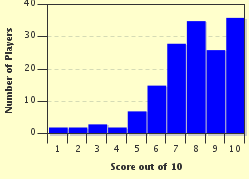Quiz Answer Key and Fun Facts
1. A desert located on the US-Mexican border is definitely not deserted because it is home to several major cities including Cuidad Juárez on the Mexican side and El Paso, Texas on the American side. What is this desert called?
2. The Nebraska Sandhills is an example of a paleodesert - an area where climate change over a long period of time has allowed the sand dunes to become stabilised by vegetation. What major industry is the economy of this area dependent on?
3. The western end of the Sahara Desert is marked by the Atlantic coastline and includes the city of Nouakchott. In which northern African nation would you find Nouakchott?
4. The Three-North Shelterbelt Forest Programme was introduced by the Chinese government in 1978 in an attempt to prevent one of the world's deserts encroaching into populated areas of the country. The apparent expansion of which desert prompted this action?
5. The cold, inhospitable land of the Patagonian Desert of South America holds some clues to the fact that the area has been inhabited by the Tehuelche people for around 15,000 years. Which of these features might you see if you took a trip to this end of the Earth?
6. Located in the states of Western Australia and South Australia, the Great Victoria Desert is the largest in the country and, like most deserts, is sparsely populated. This made it an apparently ideal location for what type of activity?
7. The state tree of Rajasthan, Prosopis cineraria, is a key species for the economy of which of the world's deserts?
8. The 'Flowering Desert' phenomenon can be seen in which desert of South America, located along the coast of Chile?
9. The Mojave Desert can't really be described as an 'end of the Earth' as it is located in the United States of America and is home to one of the most vibrant and populous cities in the country. What is the official name of the city in the Mojave Desert that, amongst other things, is also known as 'Sin City' and 'The Entertainment Capital of the World'?
10. The Namib and Kalahari Deserts of south-west Africa are home to a variety of animal species, including Suricata suricatta. What is the common name of this desert-dwelling species?
Source: Author
Fifiona81
This quiz was reviewed by FunTrivia editor
Tizzabelle before going online.
Any errors found in FunTrivia content are routinely corrected through our feedback system.

